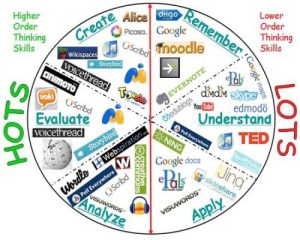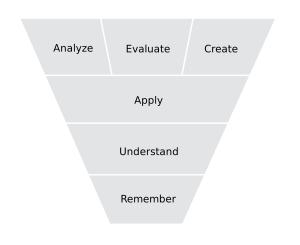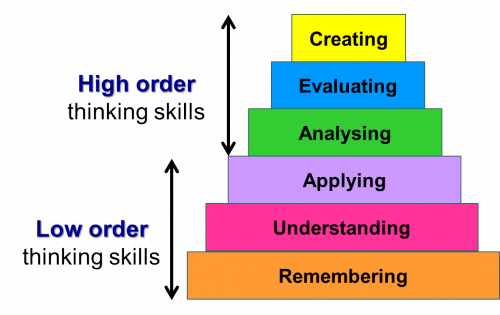Why are Higher Order Thinking Questions for Science Education Very Important?

In traditional science education, students are often expected to memorize scientific facts and concepts without fully understanding them. While memorization is important, it is not enough for students to become proficient in science. Science is all about asking questions, investigating, analyzing data, and developing explanations. To do this, students need to be able to think critically and creatively, and this is where higher order thinking questions come into play.
Higher order thinking questions challenge students to think beyond memorization and recall. They require students to analyze, evaluate, and synthesize information, and to apply their knowledge to solve real-world problems. By asking these types of questions, teachers can encourage students to develop their critical thinking skills and become more confident and independent learners.
Examples of Higher Order Thinking Questions For Science

Analyzing Data
“What patterns do you notice in the data?” “What conclusions can you draw from the data?”
Analyzing data is an important skill in science, and HOTS can help students develop this skill. Teachers can ask questions that encourage students to examine data sets critically, identify patterns, and draw conclusions.
For example, in a biology class, students might be given a set of data on the growth rate of plants under different conditions. The teacher could ask questions like, “What patterns do you notice in the data?” or “What conclusions can you draw from the data?” to encourage students to think critically about the data and develop their analytical skills.
Applying Knowledge
“How can you apply what you’ve learned to solve this problem?” – Example
Applying knowledge is an essential part of science education, and HOTS can help students develop this skill. Teachers can ask questions that require students to apply their knowledge to solve real-world problems.
For example, in a physics class, students might be given a problem that requires them to calculate the force required to move an object. The teacher could ask questions like, “How can you apply what you’ve learned to solve this problem?” or “What steps do you need to take to solve this problem?” to encourage students to think critically about the problem and apply their knowledge to find a solution.
Synthesizing Information
“How can you combine what you’ve learned to develop a solution?” – Examples
Synthesizing information is another important skill in science, and HOTS can help students develop this skill. Teachers can ask questions that require students to combine different pieces of information to develop a solution to a problem.
For example, in a chemistry class, students might be given a problem that requires them to balance a chemical equation. The teacher could ask questions like, “How can you combine what you’ve learned to develop a solution?” or “What steps do you need to take to balance the equation?” to encourage students to think critically about the problem and synthesize their knowledge to find a solution.
Evaluating Information
“What evidence supports this claim?” “What are the limitations of this study?”
Evaluating information is an essential skill in science, and HOTS can help students develop this skill. Teachers can ask questions that require students to evaluate the evidence and limitations of scientific studies and claims.
For example, in a biology class, students might be asked to evaluate the evidence for a particular hypothesis. The teacher could ask questions like, “What evidence supports this claim?” or
“What are the limitations of this study?” to encourage students to think critically about the validity of the claim and the quality of the evidence.
Creating Solutions
“How can you create a solution to this problem?”
Creating solutions is an important skill in science, and HOTS can help students develop this skill. Teachers can ask questions that require students to use their creativity and problem-solving skills to develop solutions to real-world problems.
For example, in an environmental science class, students might be given a problem related to air pollution. The teacher could ask questions like, “How can you create a solution to this problem?” or “What steps would you take to reduce air pollution in your community?” to encourage students to think creatively and develop practical solutions to the problem.
How to Effectively Incorporate Higher order thinking questions for Science Lessons
Incorporating higher order thinking questions into science lessons requires careful planning and preparation. Here are some tips for teachers to effectively incorporate Higher order thinking questions for Science into their lesson plans:
- Plan ahead: Before teaching a lesson, think about the higher order thinking skills that you want your students to develop. Prepare a list of HOTS questions that you can ask throughout the lesson.
- Start small: Introduce HOTS gradually by starting with simple questions and gradually increasing the complexity of the questions over time.
- Provide scaffolding: Provide students with the support they need to answer HOTS questions. This might include providing examples, giving hints, or guiding students through the process of answering the question.
- Allow time for reflection: After asking HOTS questions, allow time for students to reflect on their answers and discuss their thinking with their peers.
- Encourage creativity: Allow students to express their ideas and solutions in creative ways, such as through drawings, diagrams, or models.
- Provide feedback: Provide students with feedback on their answers to HOTS questions. This might include pointing out strengths and areas for improvement or asking follow-up questions to encourage deeper thinking.
Conclusion On Higher order thinking questions for Science Education
Higher order thinking questions are very important tool for science teachers to engage their students in critical thinking and problem-solving. These questions require students to apply, analyze, synthesize, and evaluate information, rather than simply recall facts.
By asking HOTS questions, teachers can encourage students to develop their critical thinking skills and become more confident and independent learners. By incorporating these tips, teachers can effectively incorporate HOTS into their science lessons and help their students become proficient in science.






